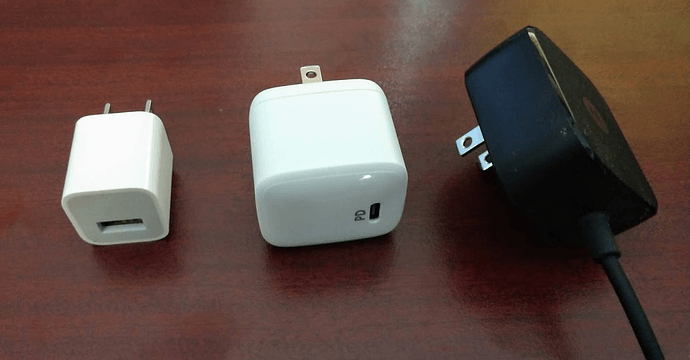Hi gang - here’s my review of the Atom PD 1, cross-posted from my blog https://mikereviewsgadgets.wordpress.com
The future of charging, if you ask Anker, is GaN. That’s gallium nitride to the uninitiated, and it’s billed as a “displacement technology” for silicon semiconductors in applications from power chargers on up the tech ladder.
GaN converts power at a higher level of efficiency than silicon, and generates less heat. That means when scaled up you can have a greater level of power conversion for the same footprint as a silicon device. Scaled down, you can achieve useful charging in a small size. A very small size.
The Atom PD 1 is has roughly the same surface area as a golf ball, more or less 1.5″ per side (though the outlet prongs do not fold away). It weighs…not much at all, though it feels reassuringly dense in the hand. There’s a lot of gallium nitride tucked away in there.
The big sell for the Atom PD 1 is that at 30 watts, it is capable of charging a new Macbook at full speed. At 40 percent the size of the stock Apple charger, that’s potentially a big deal.
But most people don’t have a new Macbook (yet). And that’s okay – Anker claims it charges your phone 2.5 times faster than its stock charger. That’s something I can test.
I have access to two devices – a Moto Z Play – a notoriously long-lasting device with a 3,510 mAh battery – and an Apple 7 Plus, which reportedly has a 2,900 mAh battery.
I ran down the battery on the Moto Z (which took quite a while) and plugged it into the Atom PD 1, using an Amazonbasics USB-C cable.
At 15 minutes the Moto Z was 25 percent charged. By the 45 minute mark it had charged to 70%. At the one hour mark 85%.
Elapsed time to full charge was 1 hour 45 minutes.
On the stock Motorola turbocharger, at 15 minutes the Moto Z was 18% charged. At the one hour mark it was 70% charged.
Elapsed time to full charge was …also around 1 hour 45 minutes.
So at least when it comes to the Motorola Moto Z Play, Anker is half right? The Atom PD got off to a quicker start, which is arguably more important in everyday use. But overall charging to 100% was virtually the same time.
To be fair, it seems Anker intends its speed claim to apply more the iPhone than Android devices. So, on to the iPhone 7 Plus.
Charging via the stock Apple charging unit is slow. Sloooow. 4+ hours to full charge slow. And there’s no quickcharge bump to start with. It’s a linear slog. In fairness, it’s a 5W charger the size of a thimble. But yeah. Slow.
A challenger appears! The Atom charged from 0 to 25% in 20 minutes. So already we’re off to the races.
At the one hour mark – 68% charged!
Within 2.5 hours we had reached full charge. That’s close enough in my book to substantiate Anker’s claim. The Atom is a huge upgrade over the stock Apple charger, and you aren’t giving up a ton in terms of size and portability.
L-R: Apple 5W USB charger | Anker 30W Atom PD 1 | Motorola 15W Turbo charger
Charging speeds aside, I have two nits to pick with the Atom PD. One, which a cursory glance at the Atom’s Amazon product page appears to be a common complaint, is that the plug doesn’t fold into the unit. So while the Atom is golf ball-small, it’s always got the plug sticking out one side, which makes it a little less wieldy in tight confines, as well as more susceptible to getting bent. To be fair here, that’s no different than either the Apple or Motorola stock charger, but many of Anker’s best chargers have foldaway plugs .
Another niggle, perhaps because I am spoiled by my various other Anker combo-chargers, is that there’s only one USB-C socket. You can’t charge more than one device, and USB-A need not apply.
Of course it’s important to bear in mind this is Anker’s first generation of GaN chargers. Based on their track record it’s impossible not to believe those issues aren’t on Anker’s radar and more flexible options are coming soon. And regardless, it’s already a gamechanger for iPhone users.






